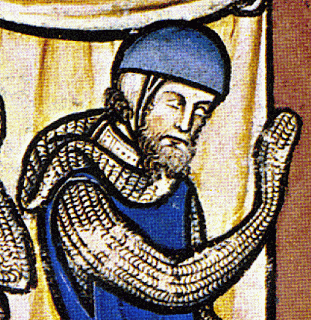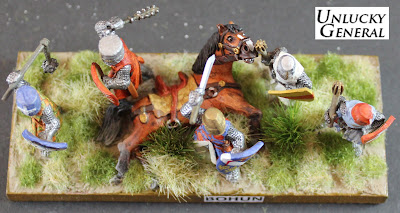Depicting Knights: Great Helms and the Cervelliere
I'm soon to commence building and painting a bodyguard unit of knights for my Rebel army and for this I have a beautiful selection of 28mm mounted figures and their dismounted equivalents from Crusader Miniatures. The interesting feature of the dismounted knight sculpts is that all of them are depicted fighting on foot and wearing the iconic great helm.
These figures look fantastic but I do not believe they are accurately portraying how knights fought on foot, so I thought to put up a short discussion on a subject you won't often find. It really cuts to the purpose and use of the great helm in this period.
Perhaps one of the reasons for a lack of discussion on the subject and likely one of the contributing factors in motivating figure sculptors is the scant evidence we have specifically for the mid-thirteenth century. Nevertheless, there are consistencies in development of helmet design preceding, following and cutting through the period which enables a clear and logical analysis of how these imposing helmets were used.
Re-enactors, living history aficionados and experimental archeologists will all confirm the insurmountable combat limitations imposed on a fighter by the fully enclosed great helm. About the only advantage to wearing the helm is the protection it affords against blows to the head. Whilst vital to be sure, this protection conversely affords no assistance in avoiding those blows it is designed to protect the wearer from.
As everyone will fully appreciate, the helm drastically reduces vision through a narrow vision port (eye slits) which is assisted to some degree through the breaths (face plate holes). Almost all peripheral vision is lost for both vertical and lateral axis. Again, the breaths provide better partial vision across the front lower field. This is not such an issue if we consider the optimal scenario for a great helm is when fixed on the head of a mounted knight armed with a lance. So armed, the knight is a forward charging offensive combination whose concern is delivery of destruction to his immediate front whilst relying on protection from the same direction. Alternatively, without support, a knight in a great helm on foot is easily outflanked and can be approached undetected from the side or rear.
The helmet also affects breathing more than you might have considered. The free passage of carbon dioxide from breathing is partially recycled: the face plate breaths having to balance airflow against protection. All of us will be uncomfortably familiar in this Covid-19 pandemic with the unpleasantness of breath retention even behind a modern 'breathable' mask. Joggers and people undertaking heavy exercise are often exempted from mask wearing because of the need for unimpeded breathing.
Whilst not denying the physicality of horse riding and even fighting from horse back, neither can compare to the extreme physical exertion of fighting on foot whilst heavily armoured. Sweating down the face, into the eyes in fine weather can be debilitating especially when you can't wipe at your eyes past a full-faced helm. Breathing becomes extreme as exhaustion threatens over an alarmingly short period of time even for a strong and fit fighter. Sustained combats did not last long. In no time the exhausting knight on foot is blowing more carbon dioxide and hot, stale breath within an extremely confined space - bound by far more steal than vents.
Beneath the great helm at the very least a knight would be wearing a padded coif or arming cap. I cannot think of a depiction of these where they do not cover the ears and I have not seen any with holes to aid hearing. The above image from the ubiquitous Majewski Bible shows just such a cap from the mid-thirteenth century. Perhaps the cervelliere which is also illustrated incorporated integral padding and a chin strap but this is one speculation. Over the top of the cap was worn the mail coif (with or without a cervelliere) so that when the great helm is fitted, the knight's hearing must have been severely restricted by padding, mail and steel plate layers.
In short, the great helm as worn in the filed affords maximum head protection along with extreme sensory deprivation. Compared to the foot soldier with a simple cervelliere or a kettle helmet, why then would a knight do this to himself?
I believe the great helm really should be viewed as the medieval equivalent of a crash-helmet. I believe it was designed for one purpose only - to protect the wearer on horseback and take him into mounted contact with the enemy. It is essentially a one-purpose piece of equipment, designed to be discarded after arrival when the combat degenerated into melee.
This supposition is supported by the later 14th century feature of retaining holes and retention chains we see in images and on sculptures. The idea was that when not in use, the helmet is removed and slung aside but available at the end of the chain (or thong) for retrieval and refitting should the need arise. Later developments of removable and adjustable visors would seem to have solved most of those problems.
The design limitations of the flat-topped great helm also suggests to me support for the exclusive use in mounted combat. Commentators point out the likelihood of flat-topped and angular surfaces catching blows and how those blows risk neck and spinal injury - particularly if struck downwards across the top of the head. It's a curious design given the conical nasal helms of the Milites which preceded this period and the reintroduction of sloped armour in the form of the Sugarloaf helm by the end of the thirteenth century.
If we accept; however, that the great helm is for mounted attack, there can have been few instances or possibilities of a knight being struck on the top of his head whilst mounted. I say this in spite of the Majewski bible's numerous illustrations to the contrary. Considering the presumably fatal blow being inflicted to the right (above) against the blue-clad knight in the cervellier, we are being asked to accept a single-handed sword stroke from horseback whist on the move was capable of splitting an rounded iron helmet, mail coif and arming cap and driving into the skull. It seems highly implausible and I'm inclined to attribute this to artistic license.
It seems to me that the angular disadvantages flat-topped great helms might have had were less than many might imagine if they were in fact only used from the height advantages from horse-back and for periods preceding a melee. I then believe that they would have been quickly discarded (perhaps even cast aside) when spacial and sensory awareness becomes paramount in the melee. This brings me to the cervelliere.
I further and consequentially believe that the cervellier was near universally adopted by this time. Removal of the great helm in melee (particularly when on foot) leaves no significant protection for the skull. The cervellier retains that protection. Worn over a cap and beneath the mail coif, the mid-twelfth century knight has no less protection than his milites predecessor and as good or better protection than any foot soldier he may be up against.
Getting back to the neck and spinal injury concerns of the flat-top great helm, we need to bear in mind that these helms were often rigged internally with fitting or adjustment harness. Made of cloth/leather the helmet harness is fitted snugly down onto the top of the knight's head providing shock-absorption through suspension and a small air-gap between the crown and the top of the helm.
These helms were extremely close fitted. They may have been tied off underneath the chin with a strap (we have evidence) but they may not have needed to be. Either way, there would have been little to no room within the helm to allow it to shift or be knocked off it's proper alignment. Given the extreme limitation of vision, even a slight movement could affect the balance of view.
Returning to the crash-helmet analogy, apart from protection against frontal strikes (arrows, lances, spears and blades), the great helm would also have provided superb protection and assurance against head injury when violently unhorsed. In this period, knights did not routinely dismount for combat - they were intended as the cavalry arm. They were nevertheless routinely dismounted when their unfortunate horses were killed or injured or when they themselves were struck from the saddle.
We have accounts of Lewes which state King Henry III had two mounts killed beneath him during the course of the battle. His Brother Richard also famously sought refuge and was held up by the Rebels in the windmill so we may presume he too was forcibly dismounted. These two examples indicate the recognised disadvantage for a knight to find himself in battle on foot. Furthermore, when on foot, the great helm which is of such an advantage in proofing against harm when mounted becomes an extreme liability.
Of course I can't finish off without considering frontal armour as proof against archery. Whilst this is undoubtedly an important consideration, so too is the paucity of archers on the field of battle in this period. Furthermore, by the time the usefulness of the helm has passed and the knight is engaged in close combat, the opportunity for archery in battle has essentially passed.
So, after due consideration, I am firmly of the view for the time being that knights depicted fighting on foot should not be wearing their great helms. If I were an armoured knight of the mid thirteenth century I might seriously consider wearing it if approaching the battlements of a castle to peek out at a besieging enemy but that's the only instance I'd wear it on foot.
Is this going to change how I model my upcoming unit of bodyguard knights? Actually, no. After going through all of that, I still love the look of the figures I have and I also embrace that romantic sinister-cool image of the fully armoured warrior. I don't think it's accurate but also the figure manufacturers don't give me much choice ... but that's alright.





Comments
I have gad the good fortune (or possibly bad fortune) to try one a number of different medieval helmets… the visibility from all of them was very limited… even a Sallet tipped over the eye drops you visibility quite significantly… and yes in any of the helmet designs you can’t hear very well..
I imagine if you were brought up to wear armour you would find it easier but just putting one on without the practice is very disorienting.
And of course I would also go for the cool looking toys with helmets 😁
All the best. Aly
Communication is also an interesting subject…
I was involved in a video conference today where a number of people were speaking at the same time… I couldn’t understand anything that was being said…
And that was with modern technology…
Imagine being in a life or death situation with a metal box on your head and trying to tell people what to do…???
I don’t think we will ever know what it was like… reenactment gives you a clue but it doesn’t really recreate the reality of medieval combat.
I know for sure that I wouldn’t want to be there😱💀💀
All the best. Aly